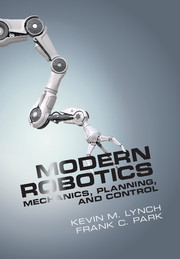Book contents
- Frontmatter
- Contents
- Foreword by Roger Brockett
- Foreword by Matthew Mason
- Preface
- 1 Preview
- 2 Configuration Space
- 3 Rigid-Body Motions
- 4 Forward Kinematics
- 5 Velocity Kinematics and Statics
- 6 Inverse Kinematics
- 7 Kinematics of Closed Chains
- 8 Dynamics of Open Chains
- 9 Trajectory Generation
- 10 Motion Planning
- 11 Robot Control
- 12 Grasping and Manipulation
- 13 Wheeled Mobile Robots
- A Summary of Useful Formulas
- B Other Representations of Rotations
- C Denavit–Hartenberg Parameters
- D Optimization and Lagrange Multipliers
- Bibliography
- Index
A - Summary of Useful Formulas
Published online by Cambridge University Press: 04 June 2024
- Frontmatter
- Contents
- Foreword by Roger Brockett
- Foreword by Matthew Mason
- Preface
- 1 Preview
- 2 Configuration Space
- 3 Rigid-Body Motions
- 4 Forward Kinematics
- 5 Velocity Kinematics and Statics
- 6 Inverse Kinematics
- 7 Kinematics of Closed Chains
- 8 Dynamics of Open Chains
- 9 Trajectory Generation
- 10 Motion Planning
- 11 Robot Control
- 12 Grasping and Manipulation
- 13 Wheeled Mobile Robots
- A Summary of Useful Formulas
- B Other Representations of Rotations
- C Denavit–Hartenberg Parameters
- D Optimization and Lagrange Multipliers
- Bibliography
- Index
Summary
Chapter 2
• dof = (sum of freedoms of bodies) − (number of independent configuration constraints)
• Gr¨ubler's formula is an expression of the above formula for mechanisms with N links (including ground) and J joints, where joint i has fi degrees of freedom and m = 3 for planar mechanisms or m = 6 for spatial mechanisms:
• Pfaffian velocity constraints take the form A(θ)θ = 0.
Chapter 4
• The product of exponentials formula for a serial chain manipulator is
where M is the frame of the end-effector in the space frame when the manipulator is at its home position, Si is the spatial twist when joint i rotates (or translates) at unit speed while all other joints are at their zero position, and Bi is the body twist of the end-effector frame when joint i moves at unit speed and all other joints are at their zero positions.
Chapter 5
• For a manipulator end-effector configuration written in coordinates x, the forward kinematics is x = f(θ), and the differential kinematics is given by x˙ = (∂f/∂θ)θ˙ = J(θ)θ˙, where J(θ) is the manipulator Jacobian.
• Written using twists, the relation is V∗ = J∗(θ)θ˙, where ∗ is either s (for a space Jacobian) or b (for abody Jacobian). The columns Jsi, i = 2, … , n, of the space Jacobian are
with Js1 = S1, and the columns Jbi, i = 1, … , n−1, of the body Jacobian are
with Jbn = Bn. The spatial twist caused by joint-i motion is altered only by the configurations of joints inboard from joint i (i.e., between the joint and the space frame), while the body twist caused by joint i is altered only by the configurations of joints outboard from joint i (i.e., between the joint and the body frame).
The two Jacobians are related by
- Type
- Chapter
- Information
- Modern RoboticsMechanics, Planning, and Control, pp. 490 - 496Publisher: Cambridge University PressPrint publication year: 2017

